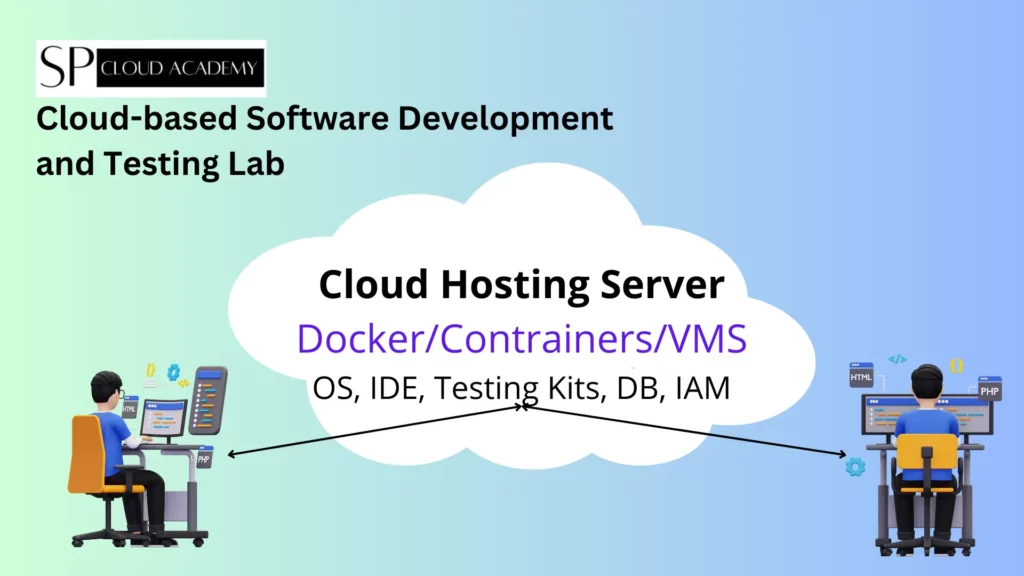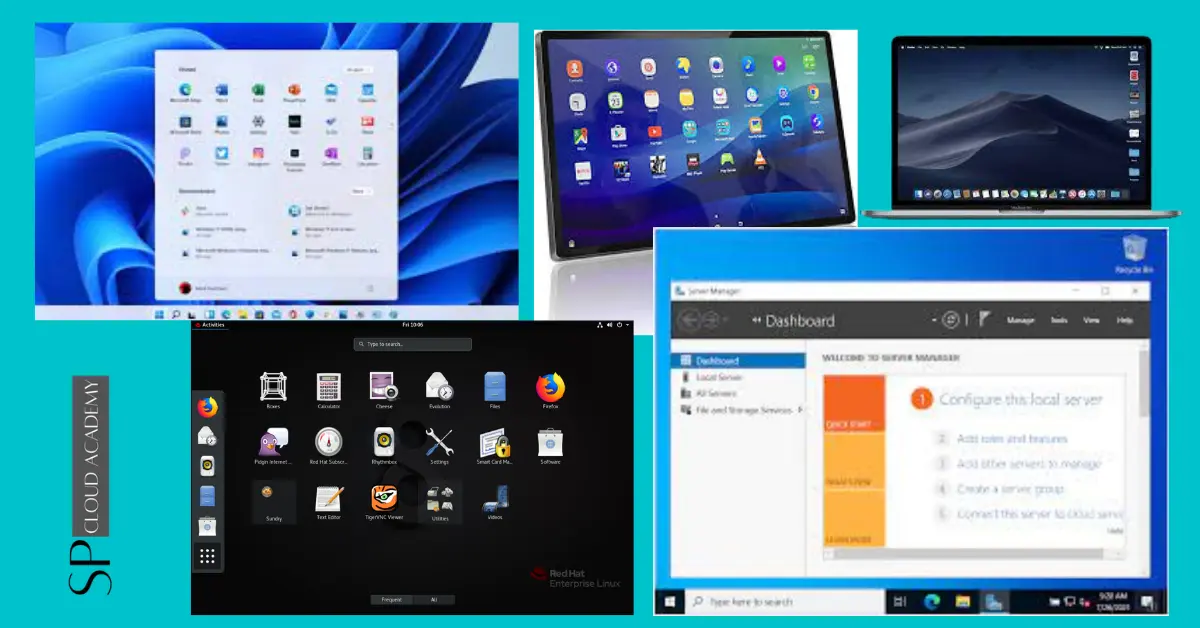Cloud-based Software Development and Testing Labs are virtual environments hosted on cloud computing platforms that provide a comprehensive set of resources, tools, and infrastructure for software development and testing activities. These labs offer several advantages:
- On-Demand Resources: Users can provision and scale virtual machines, databases, and other resources as needed, eliminating the need for physical hardware.
- Collaboration: Teams can work collaboratively, regardless of their physical location, by accessing a shared development and testing environment.
- Cost-Efficiency: Cloud-based labs reduce upfront infrastructure costs and offer pay-as-you-go pricing models, optimizing resource utilization.
- Versatility: A variety of operating systems, development frameworks, and testing tools can be readily available for diverse project requirements.
- Rapid Prototyping: Developers can quickly create and experiment with new software iterations without the constraints of physical hardware.
- Automated Testing: Automation tools and continuous integration/continuous deployment (CI/CD) pipelines can be seamlessly integrated into the lab environment.
- Security and Compliance: Cloud providers offer robust security measures and compliance certifications, enhancing data protection.
- Scalability: Teams can easily scale resources up or down based on project demands, ensuring optimal performance.
Overall, Cloud-based Software Development and Testing Labs enhance efficiency, flexibility, and collaboration in software development while reducing costs and infrastructure management overhead.
Components and services
Cloud-based Software Development and Testing Labs comprise various components and services that work together to facilitate software development and testing in the cloud. Here are some key components:
- Cloud Infrastructure: This forms the foundation of the lab, consisting of virtualized servers, storage, and networking resources provided by cloud service providers like AWS, Azure, or Google Cloud.
- Virtual Machines (VMs): VMs are used to create development and testing environments with specific configurations, operating systems, and software stacks.
- Containers: Containers, managed by platforms like Docker or Kubernetes, enable the deployment and isolation of applications and their dependencies, ensuring consistency across environments.
- Development Tools: Integrated development environments (IDEs), code editors, version control systems (e.g., Git), and collaboration tools facilitate software coding and collaboration.
- Testing Tools: Various testing frameworks and tools for unit testing, integration testing, regression testing, load testing, and automated testing are essential for validating software functionality.
- Database Services: Cloud-based databases (SQL and NoSQL) store and manage application data, ensuring scalability and data consistency.
- CI/CD Pipelines: Continuous Integration/Continuous Deployment pipelines automate code integration, testing, and deployment processes, ensuring rapid and reliable software delivery.
- Monitoring and Logging: Tools for monitoring application performance, tracking issues, and collecting logs enable proactive problem detection and resolution.
- Security Measures: Security services, such as identity and access management (IAM), encryption, and firewall configurations, are essential to protect data and applications.
- Scalability and Load Balancing: Autoscaling mechanisms and load balancers ensure that the lab can handle varying workloads and maintain high availability.
- Resource Orchestration: Infrastructure as Code (IaC) tools like Terraform or CloudFormation enable the automated provisioning and management of resources.
- Collaboration and Communication: Messaging platforms, project management tools, and communication channels facilitate collaboration among team members.
- Compliance and Governance: Implementing policies and procedures to adhere to regulatory requirements and organizational standards.
- Backup and Disaster Recovery: Regular backups and disaster recovery plans safeguard data and applications against unexpected failures.
- Cost Management: Tools and strategies for monitoring and optimizing cloud costs to ensure efficient resource utilization.
- User Access and Identity Management: Managing user access rights, permissions, and authentication to secure the lab environment.
- Documentation and Knowledge Sharing: Centralized documentation and knowledge sharing platforms assist in maintaining and disseminating information.
These components work together to create a dynamic and scalable environment that supports the entire software development and testing lifecycle in the cloud, offering flexibility, collaboration, and efficiency to development teams.
Deployment Procedures
Deploying a Cloud-based Software Development and Testing Lab involves a series of steps to set up and configure the necessary infrastructure, tools, and environments for software development and testing in the cloud.

Here’s an overview of deployment procedures:
Define Objectives and Requirements:
- Determine the specific goals and requirements of your development and testing lab.
- Identify the types of software and applications you’ll be developing and testing.
Select a Cloud Provider:
- Choose a cloud service provider (e.g., AWS, Azure, Google Cloud) that aligns with your needs and budget.
Plan Resource Allocation:
- Decide on the virtual machines (VMs), storage, networking, and other resources needed for your lab.
- Consider scalability and future resource requirements.
Set Up Networking:
- Configure virtual networks, subnets, and security groups to isolate and secure your lab environment.
- Establish connectivity options for remote access if required.
Provision Virtual Machines:
- Create VM instances with the desired operating systems and specifications.
- Install necessary development tools, libraries, and dependencies on these VMs.
Containerization (Optional):
- If using containers, set up container orchestration platforms like Docker or Kubernetes.
- Create Docker images and define Kubernetes pods and services as needed.
Database Configuration:
- Deploy and configure cloud-based databases (SQL or NoSQL) for storing application data.
- Set up database connections and credentials.
Development and Testing Tools:
- Install and configure integrated development environments (IDEs), code editors, version control systems, and testing tools.
- Customize development environments for different projects or teams.
CI/CD Pipeline Setup:
- Implement CI/CD pipelines using tools like Jenkins, Travis CI, or GitLab CI.
- Configure automated build, test, and deployment processes.
Security Measures:
- Implement security measures, including access control, encryption, and firewall rules.
- Regularly update security policies and audit configurations.
Monitoring and Logging:
- Set up monitoring tools (e.g., Prometheus, Grafana) to track system performance and application health.
- Configure logging to capture relevant events and errors.
Load Balancing and Autoscaling:
- Implement load balancers to distribute traffic evenly and ensure high availability.
- Configure autoscaling policies to adapt to varying workloads.
Backup and Disaster Recovery:
- Establish backup and disaster recovery procedures to protect data and applications.
- Test data recovery processes periodically.
User Access and Identity Management:
- Configure user access controls and role-based access control (RBAC) policies.
- Implement single sign-on (SSO) if necessary.
Compliance and Governance:
- Ensure compliance with relevant industry regulations and company policies.
- Implement governance practices to maintain control over resources.
Documentation and Training:
- Create comprehensive documentation for lab setup, configurations, and best practices.
- Provide training to team members on lab usage and procedures.
Cost Management:
- Monitor and optimize cloud costs through budgeting and resource tagging.
- Implement cost control measures to avoid unexpected expenses.
Testing and Validation:
- Thoroughly test the lab environment to ensure it meets the specified requirements.
- Conduct user acceptance testing (UAT) to validate usability.
Deployment Automation (Optional):
- Use infrastructure as code (IaC) tools like Terraform or CloudFormation to automate resource provisioning and configuration.
Maintenance and Updates:
- Regularly update software, security patches, and configurations to keep the lab environment current and secure.
Scale as Needed:
- Continuously monitor resource utilization and scale resources up or down based on demand.
Ongoing Monitoring and Optimization:
- Monitor system performance and costs, making adjustments as necessary for optimization.
By following these deployment procedures, you can establish a robust Cloud-based Software Development and Testing Lab that supports agile development, collaboration, and efficient software testing in the cloud environment.
VM, Docker and Contrainer
Here are definitions for “VM” (Virtual Machine), “Docker,” and “Container”:
- Virtual Machine (VM): A Virtual Machine (VM) is a software-based emulation of a physical computer. It runs an operating system and applications just like a physical computer but is hosted on a physical server. VMs allow multiple operating systems to run on a single physical machine, known as the host, and each VM operates independently, isolated from the others. VMs are widely used for server virtualization, where they enable efficient resource utilization, isolation, and flexibility in managing and deploying software and services.
- Docker: Docker is a platform for developing, shipping, and running applications in containers. Containers are lightweight, standalone, and executable packages that include all the necessary components to run an application, including the code, runtime, system tools, and libraries. Docker uses containerization technology to package applications and their dependencies into standardized containers, making it easy to deploy and run software consistently across different environments, such as development, testing, and production. Docker is known for its portability, scalability, and ease of use.
- Container: A container is a lightweight, standalone, and executable package that contains everything needed to run an application, including the code, runtime, system tools, libraries, and settings. Containers are based on containerization technology, which isolates and encapsulates an application and its dependencies from the underlying infrastructure. This isolation ensures that containers run consistently and predictably across various environments and platforms. Containers are ideal for deploying and managing applications in a highly efficient and portable manner, making them a popular choice for modern software development and deployment workflows.
In summary, VMs emulate entire computer systems, Docker is a platform for containerization, and containers are self-contained units that package applications and their dependencies for consistent and efficient deployment.





